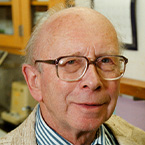
Arthur B. Pardee, PhD, FAACR, a past president of the AACR who conducted pioneering research in molecular biology, died February 24, 2019, at the age of 97.
Pardee was born July 13, 1921, in Chicago. He earned a bachelor of science degree from University of California, Berkeley, in 1942, and his PhD from California Institute of Technology in 1947. He held four long-term positions in academia: faculty member at Berkeley from 1947 to 1961; chair of the Biomedical Sciences department at Princeton University from 1961 to 1975; professor at Harvard Medical School from 1975 to 1992, and researcher at Dana-Farber Cancer Institute from 1975 to the time of his death.
Pardee’s research included several discoveries that helped form the foundation of modern molecular biology. In 1959, while on a sabbatical at the Pasteur Institute in Paris, he and two colleagues conducted the PaJaMo (Pardee/Jacob/Monod) experiment, which demonstrated genetic regulation of gene expression and led to the discovery of messenger RNA (mRNA) in 1960.
In the 1970s, Pardee discovered the restriction point (sometimes called the Pardee point) in which a cell commits itself to certain cell cycle events during the G1 phase. In the 1990s, Pardee co-invented differential display, a method to detect the mRNAs expressed in a given cell type.
Pardee joined the AACR in 1974. He served on the Board of Directors from 1983 to 1986 and as president for the 1985-1986 term. During his presidency he was instrumental in strengthening AACR’s programs in molecular biology and genetics, and he attracted many molecular biologists to the membership.He became an Emeritus member of the AACR in 2005 and was elected to the inaugural class of fellows of the AACR Academy in 2013.
Pardee received extensive recognition for his scientific contributions, including the American Chemical Society Paul Lewis Award in 1960, the Federation of European Biochemical Societies Krebs Medal in 1973, the Rosenstiel Medal in 1975, the Federation of American Societies for Experimental Biology 3M Award in 1980, the Boehringer Mannheim Award in 1998, and the Distinguished Alumni Award, California Institute of Technology, in 1999.
Pardee was elected to the National Academy of Sciences, the Institute of Medicine, the American Academy of Arts and Sciences, and the American Philosophical Society. He also served as president of the American Society of Biochemistry and Molecular Biology.
“Arthur Pardee made pivotal contributions to the field of molecular biology, laying a foundation for much of the progress that has been made against cancer over the past few decades,” said Margaret Foti, PhD, MD (hc), chief executive officer of the AACR. “His innovative spirit and tireless commitment to cancer science made him an icon to his fellow scientists and leave an important legacy.”
Career Highlights
1999 Distinguished Alumni Award, California Institute of Technology
1998 Boehringer Mannheim Award
1985-1986 President, AACR
1983-1986 Board of Directors, AACR
1980 FASEB 3M Award
1980 President, American Society of Biological Chemists
1975 Professor, Biological Chemistry and Molecular Pharmacology, Harvard Medical School, and Dana-Farber Cancer Institute, Boston MA
1975 Rosenstiel Medal
1974 Elected Member, Institute of Medicine
1973 Sir H. A. Krebs Medal, Federation of European Biochemical Societies
1968 Elected Member, National Academy of Sciences, Washington, D.C.
1963 Elected Fellow, American Academy of Arts and Sciences
1961-1974 Professor of Biochemical Sciences, Princeton University
1960 Paul Lewis Award, American Chemical Society
1947 PhD, California Institute of Technology